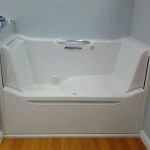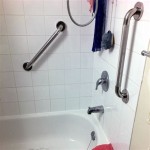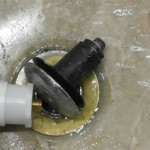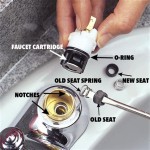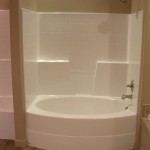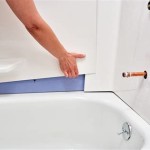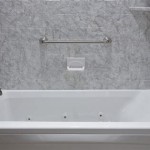Water Tank Bathtub: An Innovative Approach to Bathing
The concept of a water tank bathtub represents a niche yet potentially impactful adaptation of existing plumbing infrastructure for personal hygiene. It leverages the inherent advantages of water storage tanks – capacity, temperature regulation potential, and pressure – to create a unique bathing experience. Understanding the fundamentals of this design, its potential benefits, challenges, and appropriate applications is crucial for evaluating its feasibility and effectiveness as a bathing solution.
At its core, a water tank bathtub involves repurposing or designing a water tank specifically to function as a bathtub. This typically involves modifications to the tank structure, including the addition of access points (entry and exit), appropriate sealing and lining materials for hygiene and safety, temperature control mechanisms, and drainage systems. The design considerations go beyond simply filling a tank with water; they encompass the integration of comfort, safety, and efficient water management.
Key Point 1: Design and Construction Considerations
The design and construction of a water tank bathtub are paramount to its success. Several critical factors must be considered to ensure functionality, safety, and longevity. The primary material selection is of utmost importance. While traditional water tanks are often constructed from galvanized steel or polyethylene, materials suitable for a bathtub must be non-toxic, resistant to corrosion and chemical degradation (from bath products), and capable of maintaining structural integrity under the weight of water and a bather. Stainless steel, fiberglass with appropriate gel coats, or certain food-grade plastics are potential alternatives, each with its own set of advantages and disadvantages regarding cost, durability, and heat retention.
Sealing is another crucial aspect. Any seams, joints, or access points must be meticulously sealed to prevent leaks. The sealant used must be waterproof, durable, and non-reactive with water and bath products. The internal lining of the tank, if any, should be smooth, non-porous, and easy to clean to prevent the growth of bacteria and mold. The lining material should also be resistant to staining and discoloration from bath additives like essential oils or bath bombs.
Entry and exit points require careful design to ensure accessibility and safety. A sturdy step or ladder may be necessary, particularly for deeper tanks. The entry point should be wide enough to allow for easy entry and exit without requiring awkward or strenuous movements. Handrails or grab bars can be strategically placed to provide additional support and stability. The risk of slipping should be mitigated by using non-slip surfaces for both the entry point and the interior of the tank.
Finally, proper drainage is essential. The tank must be equipped with a drain that is large enough to quickly and efficiently empty the water. The drain should be positioned at the lowest point of the tank to ensure complete drainage. A standard bathtub drain with an overflow preventer can be adapted for this purpose. The drain should be connected to a suitable wastewater disposal system, complying with local plumbing codes and regulations.
Key Point 2: Temperature Control and Heating Options
One of the primary advantages often cited for water tank bathtubs is the potential for superior temperature control and heat retention. The large volume of water in a tank can act as a thermal mass, maintaining a consistent water temperature for a longer period compared to a standard bathtub. However, this requires an effective heating system and insulation to prevent heat loss.
Several heating options can be considered. A traditional electric or gas water heater can be used to pre-heat the water before it is transferred to the tank. This method is relatively straightforward but can be energy-intensive, especially for larger tanks. Alternatively, an on-demand water heater can be connected directly to the tank, providing a continuous supply of hot water as needed. This approach is more energy-efficient but requires a powerful heater capable of meeting the flow rate demands of filling the tank.
Immersion heaters, placed directly inside the tank, are another heating option. These heaters are relatively inexpensive and easy to install but require careful monitoring to prevent overheating and potential electrical hazards. Solar water heaters can also be integrated into the system, providing a sustainable and cost-effective source of hot water in sunny climates. This option requires a solar collector panel and a storage tank (separate from the bathtub tank) to pre-heat the water before it enters the bathtub.
Regardless of the heating method chosen, proper insulation is crucial to minimize heat loss. The tank should be insulated with a high-quality insulation material, such as fiberglass, foam, or mineral wool. The insulation should be applied to the exterior of the tank, covering all surfaces, including the bottom and sides. The thickness of the insulation should be sufficient to provide adequate thermal resistance, reducing heat loss and minimizing energy consumption.
Temperature monitoring and control are also essential for safety and comfort. A thermometer should be installed to monitor the water temperature. A thermostatic mixing valve can be used to regulate the water temperature, preventing scalding and maintaining a consistent temperature throughout the bathing session. This valve blends hot and cold water to achieve the desired temperature, ensuring a safe and comfortable bathing experience.
Key Point 3: Potential Benefits and Limitations
The water tank bathtub offers several potential benefits, primarily related to capacity and temperature management. The larger volume of water allows for complete submersion and a more immersive bathing experience. This can be particularly beneficial for individuals seeking therapeutic benefits, such as muscle relaxation and pain relief. The ability to maintain a consistent water temperature for a longer period can also enhance the relaxing effect of the bath.
The potential for integrating various water features, such as jets or massage systems, is another advantage. The larger tank capacity can accommodate these features more easily than a standard bathtub. Water jets can provide a massaging effect, stimulating circulation and relieving muscle tension. Underwater lighting can also be added to create a more relaxing and visually appealing atmosphere.
However, the water tank bathtub also presents several limitations. The primary limitation is the space requirement. Water tanks are typically larger than standard bathtubs, requiring a dedicated space in the bathroom. The weight of the filled tank is another consideration. The floor must be structurally sound enough to support the weight of the tank and the water it contains. This may require reinforcement of the floor structure in some cases.
Water consumption is another concern. Filling a large tank requires significantly more water than filling a standard bathtub. This can be a problem in areas with water scarcity or high water costs. Water heating costs are also higher due to the larger volume of water. While insulation can help to reduce heat loss, the initial heating costs are still substantial.
Hygiene and maintenance are also important considerations. The larger surface area of the tank requires more effort to clean and maintain. The tank must be regularly cleaned to prevent the growth of bacteria and mold. The internal lining, if any, must be inspected regularly for signs of damage or wear. The drainage system must also be maintained to prevent clogs and ensure proper drainage.
Finally, the aesthetic appeal of a water tank bathtub can be a limitation. Water tanks are not typically designed to be visually appealing. However, with careful design and customization, it is possible to create a water tank bathtub that is both functional and aesthetically pleasing. This may involve cladding the tank with decorative materials, such as wood or tile, or incorporating it into a larger bathroom design.
Ultimately, the decision to install a water tank bathtub requires careful consideration of the potential benefits, limitations, and logistical challenges. It is essential to consult with qualified professionals, such as plumbers, engineers, and contractors, to ensure that the installation is safe, compliant with local codes and regulations, and meets the specific needs and requirements of the user.

10 Amazing Tin Bathtubs For The Best Farmhouse Decor

Very Modern Tub Or Stock Tank

Stock Tank Bathtubs Are Trending Purewow

Making A Bathtub From Trough We Love It

Bathroom On A Budget Stock Tank Bathtubs The Interiors Addict

Steel Stock Tank Water Trough Bathtub Install

Just Right Bus Living With A Water Trough Bathtub

Stock Tank Bathtubs Are Trending Purewow

How To Build A Bathtub With Galvanized Stock Tank Hunker

Stock Tank Tub Trends
Related Posts

